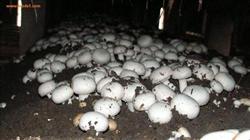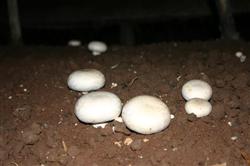Key points of planting techniques of Pleurotus ostreatus in greenhouse

I. Specifications of greenhouse: 20 meters long and 12 meters wide, covering an area of 1.2 mu (including mixing yard, living room, road, etc.), 8 bamboo racks are built inside, and the planting area is 1000 square meters. 2. Culture medium formula (1000 square meters): straw 22500 kg, cow dung 3000 kg, vegetable cake 1000 kg, compound fertilizer 400 kg, urea 100 kg, ammonium hydrogen phosphate 150 kg, calcium superphosphate 500 kg, gypsum 500 kg, lime 250 kg, carbon nitrogen ratio 31.8: 1. 3. Planting time: August to April of the next year. Strain: AS2796, 1.2 bottles per square meter (500 ml). 5. Fermentation: 1. First fermentation. (1) weighing cake, dried cow dung, urea, gypsum powder and calcium superphosphate according to proportion 2 days in advance, mixing well, pre-wetting and stacking, and covering with plastic film for standby;(2) shaking rice straw and pre-wetting for 24 hours;(3) building pile: a layer of rice straw (5~6 inches) and a layer of manure (spread), totaling 9 layers, watering each layer properly, and finally a small amount of water flowing out from the bottom;(4) turning pile: turning for the first time 5~6 days after building pile, adding ammonium bicarbonate, and turning it once in the next 4 days, totally 3 times. Lime is added in the second and third turning, about 15 days, the temperature of the material is stable at 50~60℃, and the material is transferred into the mushroom shed after 2 days. Second fermentation. The upper layer and the lower two layers do not discharge materials. 7~8 coal stoves are put into each greenhouse, the greenhouse is tightly closed, the temperature is raised to 60 DEG C, and the temperature is kept for 8 hours; the fire is reduced, the temperature is controlled at 48~52 DEG C, and the temperature is kept for 4 days; the four corners are opened for ventilation for 10~20 minutes every day during the temperature control stage. VI. Disinfection. Before planting, thoroughly disinfect the inside and outside bedstead of mushroom shed with lime water and dichlorvos, remove impurities on the ground and sprinkle a layer of lime. VII. Sowing. After fermentation, when the material has no ammonia smell, sow again. Firstly, spray mushroom shed with 0.1% solution of Clomyl and 40% dichlorvos 1000 times; secondly, ventilate and cool down, open vent hole and door, and control temperature below 28 DEG C; thirdly, assist material evenly; fourthly, adjust water content to 60%, break strain fine and spread evenly. 3 days after sowing, close the mushroom shed, keep warm and keep moisture, 5 days to before covering soil, mainly control temperature, control temperature at about 25℃, cover soil when mycelium grows through the material layer. Cover material. 24 tons of pond mud, 6000 jin of chaff added (volume ratio 1:1), the pond mud added with chlorpheniramine and lime stirred evenly, the chaff pre-wet sprayed with dichlorvos and lime, closed with plastic film for 2 days, the mud and chaff mixed evenly before soil covering, the moisture content is 20 - 22%, and the uniform mud covering thickness is 3.5 cm. When the mud dried hyphae grow out of mud cracks covered with treated small particles of loess 1 cm. 8. fruiting management. Cover the soil for about 15~18 days, keep the temperature of the shed at 20~25℃, keep the air humidity at about 80%, and spray water on the cover layer. When the temperature drops below 18℃, spray mushroom water, requiring light and uniform spray of 3 jin water per square meter. When mushroom bud soybean size, spray mushroom water, light spray, spray nozzle upward 45 degrees oblique spray. When the grape is large, increase the amount of water spray, maintain the air humidity at 85~90%, and ventilate when spraying water. IX. Harvest. Harvest mushrooms before they open.
- Prev

Disease Control measures of Pleurotus ostreatus
The principle of disease control: give priority to prevention, with equal emphasis on prevention and control. 1. Rot disease: fungal disease, mainly characterized by the appearance of white hyphae as thin as spider silk on the overlying soil layer of the mushroom bed, which grows irregularly and shows a spider web. The infected mushroom body basically stops growing and gradually turns brown, soft and rotten. Prevention and control measures: deal with soil cover.
- Next

Eight key points of Disease and Pest Control of Pleurotus ostreatus
With the rapid development of mushroom production, it is the direction of growers and related technicians to improve economic benefits and reduce costs. There is a large amount of corn straw in North China, which can greatly reduce the cost of mushroom cultivation instead of rice straw. The related techniques are introduced as follows: 1. Mushroom culture material formula.
Related
- Fuxing push coffee new agricultural production and marketing class: lack of small-scale processing plants
- Jujube rice field leisure farm deep ploughing Yilan for five years to create a space for organic food and play
- Nongyu Farm-A trial of organic papaya for brave women with advanced technology
- Four points for attention in the prevention and control of diseases and insect pests of edible fungi
- How to add nutrient solution to Edible Fungi
- Is there any good way to control edible fungus mites?
- Open Inoculation Technology of Edible Fungi
- Is there any clever way to use fertilizer for edible fungus in winter?
- What agents are used to kill the pathogens of edible fungi in the mushroom shed?
- Rapid drying of Edible Fungi

